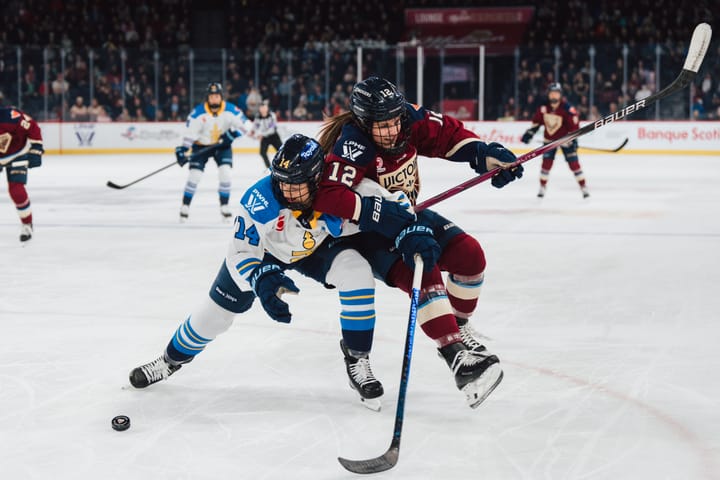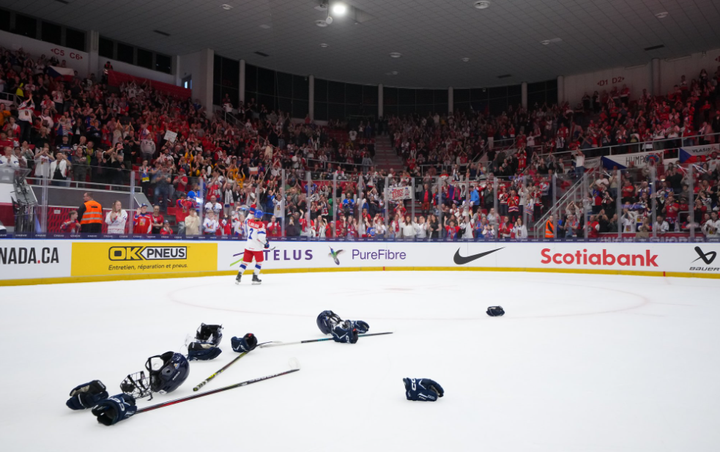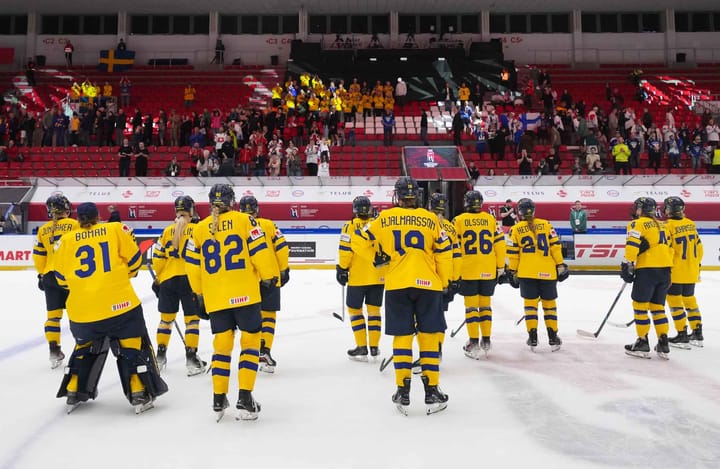NCAA Year in Review: Boston University, Colgate, and Providence
Last out of the tournament from the East — what do we think of their season?
As the NCAA women’s hockey season winds down, writers Gabriella Fundaro and William Whyte are taking an in-depth look at how each team has shaped up in 2018-19. It’s time to look at the Eastern teams that almost but didn’t quite make it.
Boston University
Gabriella: After losing a 67-point scorer and a 57-point scorer from last season (Victoria Bach and Rebecca Leslie, respectively) I don’t think anyone expected the Terriers to keep pace, let alone improve. But Jesse Compher and Sammy Davis emerged as the team’s new go-to scorers, Corinne Schroeder settled beautifully into the starting role in net, and BU went from sixth place in Hockey East (8-11-5, 14-17-6 overall) to third (15-6-6, 21-8-8 overall).
It seems like goaltending was the biggest difference for the Terriers, but I don’t think the play of Compher should be understated, either. Before the season, I thought she was an easy pick to have a breakout year, but she went above and beyond that, leading Hockey East in scoring with 61 points and earning a nod as a Patty Kazmaier top-10 finalist. What aspect of BU’s season, and their improvements overall, most impressed you?
William: Of all the non-CHA teams whose season ended last weekend, BU are probably the most satisfied with the year they just had. They lost Bach and Leslie, and looked ready to take a big step back, but once they found their stride they were very dangerous and ended the season ranked in the polls and one-win-and-some-luck away from an at-large bid to the national tournament.
They had a narrow loss to BC in November, which already seemed like a better result than BU was expecting on paper. What really got people’s attention, though, was a weekend sweep of BC (again) ten days later. Then Compher caught fire: she went from a respectable eight points in her first seven games, to 16 in her first ten, to 31 in her first sixteen -- from just above a point per game to just below two. Compher ignited Davis, who had two nine-game points streaks during the season and ended on 52 points, not bad for coming back from an injury year.
Compher is unusual among superstars in that the stats show her primarily as a playmaker: she had 17 goals and 44 assists to make up her 61 points. That seems like very few goals for that many points, and it is. Looking at players who scored 40 or more points this season, Compher was one of only four to have her goals make up less than a third of her points. (The average is .84, and seven players got more than half their points from goals). Whatever the opposite of a puck hog is, Compher’s that. Her value wasn’t just her own aggressiveness, but how she brought up her linemates, Davis and thirteen-goal, six-assist Mackenna Parker. That kind of good play seems easier to sustain than the play of a sniper who hits a hot streak.
I suppose I’m most impressed by how BU keep it going. They lose Poulin and suddenly Sarah Lefort is setting the program record for goals. They lose Lefort and there are Bach and Leslie to take up the slack. They lose Bach and Leslie after a disappointing season and come back stronger than ever with Compher and Davis. The highest scoring senior they graduate is Reagan Rust with only 13 points. Next year they could be scary good.
Stick taps: BU won its very first Beanpot title as a varsity program in thrilling fashion, first knocking off Northeastern in a shootout and then defeating Harvard in overtime of the title game on this dazzling play from Compher and Davis.
We're the best of Boston in 2019 thanks to this overtime goal! #GoBU pic.twitter.com/OkKjydJW6b
— BU Women's Hockey (@TerrierWHockey) February 13, 2019
Losing an edge: For as much progress as the Terriers saw this year, they did not get off to a very good start to the season, winning just one of their first seven games.
This wasn’t just for our team. This was for everyone that's ever put on a Terrier uniform. pic.twitter.com/7RB72U6tu6
— BU Women's Hockey (@TerrierWHockey) February 13, 2019
Colgate
Gabriella: I thought the Raiders might have a little more left in them after a very solid ending to the regular season, but after falling to Clarkson in the ECAC semifinals, they didn’t have the overall resume to warrant a bid into the NCAA Tournament. It’s a clear step back for last year’s national runner-ups, as they had to regroup after losing several major contributors to graduation. That was especially evident over the first half of the season, when the Raiders suffered losses to Penn State, Ohio State, and Brown, went winless in a series against Mercyhurst, and tied Robert Morris and Quinnipiac.
The outlook got brighter as the season wore on, though. Jessie Eldridge, Malia Schneider, and Shae Labbe emerged as one of the NCAA’s most dynamic trios up front. Olivia Zafuto shined as the team’s No. 1 D. They ended the regular season on an eight-game unbeaten streak. Unfortunately for the Raiders, they couldn’t translate that into postseason success. Did you see a big difference in Colgate’s play from the beginning of the year to the end, and did you expect them to wrap up so early this year?
William: Whatever about overall depth, the ECAC is certainly the conference with the best top-four teams, and that makes it easy to slip down from the very top. Colgate lost more scoring to graduation than anyone but Northeastern and that was always going to make them vulnerable. In fact, they didn’t slip too much on the scoring -- from 145 goals for last year, to 133 this year. Their problems were defensive. They went from 65 goals allowed to 96, almost a full goal more per game played.
Some of this seems to have been directly on the goaltending, unfortunately. Julia Vandyk had a career year last year, with a .929 save percentage overall but a .946 save percentage across the three games of the NCAA tournament. This year her overall percentage was .911 and her percentage since the start of February was just .904.
But that change in save percentage doesn’t account for all the extra goals, and it shows that the Raiders were also letting up more shots. Last year they played a high-energy game based on tight D, close support on the backcheck, and a speedy transition that took the other team by surprise. Wherever the puck was, there was a Raider crashing the play and another behind her to clean up. It was very effective, if not very structured to the casual eye, but had to be exhausting for the team, and I wonder if last year’s seniors, Greg Fargo’s first freshman class, had bought into it more than any other class could be expected to.
Next year Colgate graduate even more of their scoring -- 163 of this year’s total 333 points were scored by seniors. The good news is that 165 of their points were scored by underclassmen. Yes, they have only two juniors! And those are a defender who transferred from BC, and their backup goalie! So if they can weather the storm next year, the year after might be another one to watch.
Stick taps: Jessie Eldridge became the first player in program history to score 30 goals in a single season, and was also the school’s first Patty Kazmaier Memorial Award top-10 finalist.
Losing an edge: In ECAC play, the Raiders had a huge wake-up call in their first game against Princeton, when they were outscored 6-0.
Providence
William: Bob Deraney coached Providence from league champions in 2004-05 all the way down to a .229 win percentage in 2014-15 and back up to .554 last year, their first above-.500 season since 2011, and then unexpectedly decamped to China where he was thrown into the same coaching meatgrinder that chewed up Digit Murphy last year. His successor, Matt Kelly, was from outside the program and outside the standard coaching career path, having spent four years as USA Hockey’s Women’s National Team’s head scout. You would think Kelly’s expertise was more in recruiting than in coaching, but he took a team made entirely of Deraney’s recruits and brought it to a win percentage of .676, the highest since 2003 and the second highest of the NCAA era. Katie King Crowley and Courtney Kennedy’s work with the U18 National Team kickstarted BC’s rise to national prominence; maybe Kelly’s national team experience will help build a similar powerhouse just down I-95.
And yet… for all that they had that high win percentage, and for all that they were ranked for a lot of this season, and for all that Maureen Murphy emerged as an elite player this season (especially in the first half, which she ended in fourth place in points per game and leading the country in goals per game)... for all that, Providence didn’t seem quite as dangerous this year as they did last year. Holy Cross entering Hockey East inflated everyone’s win percentage and goal difference, and cut down massively on out of conference (OOC) games. Providence didn’t exactly aim high with its remaining OOC games, replacing games against Cornell and Princeton from last year’s schedule with … Bemidji and Penn State. They had a win against BC, but BC was missing its Four Nations players. They had a weekend sweep against a solid Merrimack. But there was no real statement win that you could point to and say “this team’s elite”. Arguably, their two best wins came right at the end of the regular season when they weren’t really in the ranking conversation any more: a 5-2 victory over a Northeastern team that just wanted to get to the finish line, and a 2-1 victory over a BU that was fighting for a tournament at-large bid.
So which Providence is real? The one that looked good but maybe wasn’t? The one that people had stopped paying attention to but that might have been good? Something else? And what will happen next year?
Gabriella: While there’s no shortage of parity in women’s hockey lately, consistency is much harder to come by; that’s the mark of any truly great team. And for as good as the Friars showed they could be, they didn’t quite have that consistency from beginning to end. Losing two games each to BU and BC in January showed they still have a bit of work to do to compete with the conference’s best and regularly turn out results in those games, but this first season under Kelly’s guidance is definitely encouraging. Opponents seemed to figure out how to neutralize Murphy, so we’ll see if she can take a step forward next year and separate herself from the pack, and if the team can develop more weapons around her so the focus isn’t always on her.
Although they seemed to slip over the second half of the year, I really liked where Providence ended up. After those big wins against Northeastern and BU, they knocked a tough Merrimack team out of the playoffs in two games, holding the Warriors to one goal over that series. When they faced Northeastern again in the semifinals, they hardly looked like a team that was going to get run over. They gave the eventual Hockey East champions a good run, outshooting the Huskies 34-18 and keeping it a one-goal game for the entire 60 minutes. Like you say, I think people (myself included) might have counted the Friars out at that point, but they did an impressive job of regrouping and figuring out what works for them at the most critical point in the season.
Stick taps: Maureen Murphy led the nation in goals per game right up to January 18th (when she was displaced by, of course, Loren Gabel).
Losing an edge: Maureen Murphy wasn’t even in the top 100 in the nation in goals per game from January 19th to the end of the season.
Maureen Murphy has been named @hockey_east Player of the Month for November! She had a point in every single game of the month and a nation-best five game winners #GoFriars pic.twitter.com/gAasLTjMdD
— Providence W Hockey (@PCWHockey) December 5, 2018





Comments ()